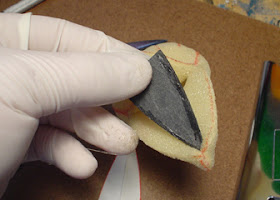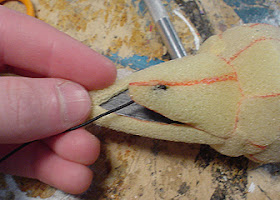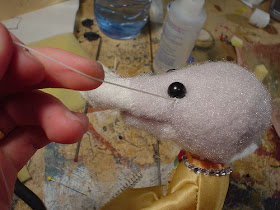How to make a rod puppet.
I didn't do this puppet but I thought it was such a good tutorial that I had to repost it.
This is from the blog puppet101.blogspot.com/.
Lady Fromage stands just over six inches tall. Her simple one handed rod control allows her to move her head left and right, and open and close her mouth. This tutorial will take you step by step through the creation of Lady Fromage. As always if you have any questions or require more clarification please write me at sean@swazzle.com.
No matter what type of puppet I'm making, big or small, hand puppet or rod puppet, I always start by sketching out the basic shapes. Because there is always some translation involved when turning a flat drawing into a three demential puppet, it's important to really understand the under-structure. Lady Fromage is fairly straight forward. Her head is a ball, her nose is flat cone, and her bottom jaw is a triangle.
Lady Fromage's head is not perfectly round, and it's made of two main parts - the skull and the snout. I'm making the skull first, the snout and mouth will be next. Because this puppet is tiny, I'm using 1/4 inch foam. Working with thin foam is very similar to working with 1/2 inch or 3/4 inch, it just takes a more steady hand because the shapes are so small.
The puppet head shape is nearly complete. To give the head a flat top, I've glued on a flat rounded foam shape to the center of the head. Next I added four small triangles to give the bottom of the puppet's head the proper roundness.
This puppet has a long pointy snout. To make that I'm using two squared triangular shapes with a one slightly curved side. The two curved sides are glued together to give the nose a slight swoop. The squared tips at the narrow end of the puppets snout, are glued together to make it rounded.
Using the same technique as the top jaw, I've constructed the puppet's bottom jaw. Like the top jaw, it was made from two triangles of foam glued together in the middle. For this puppet the bottom is just slightly smaller than the top jaw. Once the top and bottom jaws are constructed they are ready to be
attached to the puppet's head.
I'm using gasket rubber to make Lady Fromage's mouth pallet. Gasket Rubber is a good material for puppet mouths because it's light weight, strong and fairly flexible. You can find gasket rubber at your local auto supply store.
Using contact cement, glue the gasket rubber to the inside of the top and bottom jaw.
Use a thin drill bit or a blade to make a small hole in the puppet’s bottom jaw.
Thread the elastic through the hole in the puppet's mouth and tie a knot at the end. Make sure the knot is large and secure enough to keep the elastic from slipping through the hole.
Using a blade, drill a small hole in the puppet's top jaw.
Pull the elastic through the hole and tie a secure knot at the end. The elastic should be tight so that it holds the mouth closed, yet have enough give, that the puppets mouth can be opened with little resistance.
The puppet's head needs support in order to keep the top jaw form pulling down. To achieve this, I've cut a piece of gasket rubber that will fit snugly inside the puppets head. The narrow end will be pushed all the way to the puppets nose, and the large round end will fit in the puppet's skull.
Using a sharp blade or small drill, drill a small hole in the center of round end of the gasket rubber.
The rod used to turn the puppet's head will be made from piano wire. Piano wire is a great replacement for coat hanger wire (a common puppet building material with beginning puppeteers), because it is hardened steal and extremely strong. This is the same wire that I use for puppet arm rods, although for the rod puppet, I’m using a ticker gauge. Measure a couple of inches down from one end of the wire, and make a mark. Using a c-clamp and pliers carefully make a 90 degree bend at the mark.
Feed the piano wire through the hole, and glue it to the gasket rubber using Barge Contact Cement.
Using Super 90 spray glue or Barge Cement glue a piece of felt to the top of gasket rubber. This will help keep the piano wire in place.
Cut a piece of wood dowel that is about half an inch in length. Drill a hole through the center of the dowel that is just wide enough to accommodate the piano wire. Insert the piano wire into the hole. Slide the dowel down until it is flush with the gasket rubber. Glue the dowel in place with hot Glue. The dowel will help keep the piano wire in the puppet's head stable and centered.
Insert the gasket rubber into the puppet's head.
Using batting, stuff the inside of the puppet's head. This will help keep the gasket rubber and music wire in place. It will also help the puppet's head keep its shape. Be careful not to over stuff the head, or stuff it unevenly.
Using Barge Cement, glue the back of the puppet's head closed.
Now fabrication of the puppet's head can begin. I will be using Antron Fleece (commonly known as “Muppet Fleece”), to cover the puppet's head. Begin fabrication by draping your fabric over the puppet's head. Stretch it around to get as much coverage as possible, and pin it in place. Because the head is round, darts will need to be cut to achieve the proper shape. Gather the excess fabric evenly on both sides of the puppet's head.
Cut off the excess material. This will eventually be your seam, so try and cut as straight a line as possible.
Using a small whip stitch, sew the fleece together. Because the Antron
(or Muppet) fleece hides seams so well, it isn't necessary to use a fancy stitch.
Now that the gray fleece is sewn in place. It's time to add the white on the puppet's bottom jaw and muzzle.
Cut the white fleece for the puppet's bottom jaw and muzzle. It should be just large enough to cover the desired area, and lay flat next to the gray fleece.
Lay the two materials side by side and stitch them together with a small whip stitch.
Now the puppet's head is taking shape next I'll start construction on the body.
Lady Fromage's body will also be made from foam. Because she is
such a small puppet, I'm using quarter inch foam. Just like the head,
begin by planning your shapes out on paper. Create patterns of the
desired foam shapes, and cut them out using a sharp blade. I find it
helpful to put a small dot at the top of each shape, to insure that they
are glued together the right way.
Using Barge contact cement, glue the foam pieces together. This shape
will be the puppet's torso.
Lady Fromage will be wearing a formal gown that has a bell shape. I'm
using five flattened triangles to achieve that shape.
Using Barge cement, glue the foam body leaves together. Once the bell
shaped lower body and torso are constructed, glue them together. This
will form the structure of the puppet's body.
The main support for the puppet's rod control is made with a length of
one inch pvc pipe. Cut it to a size that is right for you - I would suggest
making it 12 to 15 inches long.
Measure between five to six inches from the bottom of the PVC pipe
and make a mark.
Using a fine toothed saw make a cut about half way through the pipe.
Don't make the cut too deep, or the control will loose strength and
break.
Measure about a quarter of an inch from the first cut. Use the saw to
make a second parallel cut the same depth.
Using a utility knife carefully cut between the two incisions, and
remove the quarter inch piece of plastic.
Measure about an inch or so from the bottom of the puppet's head rod,
and make a mark. Using a clamp and pliers, make a ninety degree bend
at the mark.
Thread the metal rod through the PVC pipe. Adjust the rod so the 90
degree bend at the end comes through the narrow slot. Cut a half inch
piece of wooden dowel. The dowel should be wide enough around to fit
snugly in the hole drilled in the PVC thumb control. Drill a small hole
in the center of the dowel. Fit the dowel snugly over the metal rod and
glue in place with Zap or two part epoxy.
Cut a short length of wooden dowel. The dowel should be wide enough
to fit inside the pvc pipe control. Drill a small hole through the center
of the dowel. This will be a collar that will keep the puppet's head rod
centered in the handle.
Slide the wooden collar onto the metal rod, and position it under the
puppet's head. Carve a similar shape from dense foam like L200 and
position it near the base of the rod. Both of these will keep the metal
rod centered in the pvc handle.
The thumb control for this rod puppet is made from a piece of pvc pipe.
Choose the size pipe that best fits your thumb. Cut a three quarter inch
length of pvc. Using a jig saw carefully cut the pvc piece in half. With a
medium grit sand paper round all of the rough edges so the control feels
comfortable against your thumb. Secure the pvc and drill a hole in the
center - the hole need to be just large enough to accommodate a narrow
wooden dowel.
Secure the PVC thumb control to the wooden dowel and glue it in place
with two part epoxy.
Using a clamp and pliers bend a length of piano wire into a rectangle.
The two ends of the piano wire should come together at one of the
narrow sides of the rectangle. Drill two holes on either side of the PVC
pipe just below the thumb control. Insert the piano wire into the holes.
This will become the finger trigger to control the puppet's mouth.
Drill a small hole about a half an inch down from the top of the PVC
rod. Drill a second hole about an inch and a half from the finger trigger.
Sew a piece of sturdy fishing line to the puppet's bottom jaw. Thread
the fishing line through the first hole, into the pipe, and out the second
hole.
Using Barge Cement glue a piece of felt around the metal finger
trigger.
Sew the fishing line to end of the finger trigger - the line should be
taught when the finger trigger is horizontal. When you pull down on the
trigger with your finger, the puppet's mouth will open, when you
release, the puppet's mouth will spring closed.
Slip the puppet's foam body over the PVC pipe rod. Cut away enough
foam from the top of the body to ensure that the string hole is clear.
Cut a piece of nylon string long enough to run the length of both arms.
Cut a small hole at the puppets shoulders. Thread the string through the
hole, so that each side is equal in length. Glue the holes closed around
the string with Barge Cement.
Lady Fromage's hands are cut from quarter inch foam, and covered
with white felt.
The puppet is really coming along now. Because this blog isn't
really focused on costumes, I didn't document that part of the process. I'm
sure there are plenty of great blogs and web sites dedicated to costume design
and creation - so check them out for more information. I've attached the felt
hands to the nylon arm string, now it's time to add the facial features.
Lady Fromage's eyes are made from black beads. Before you glue
the eyes in place, check the placement with pins. Once you have the placement,
glue them in place with a dab of hot glue.
Once you have found the proper placement for the puppet's eyes secure them in place. I'm using beads for Lady Fromage's eyes so they are stitched in place. Eyes can also be glued in place with hot glue, or pinned in so you can reposition them.
Using a mixture of liquid latex rubber and latex paint, paint the puppet's nose. The liquid latex rubber will preserve the foam and keep the nose from getting crunchy over time.
Now it's time to make the puppet's ears. Many different materials can be used to make ears for a puppet like this: fun foam, felt etc. - I'm using felt. To get the ears to stand upright, glue in armature wire bent to the size of the ear. This will not only give the ears rigidity, but it will make them posable.
Wrap the felt around the armature wire and glue it in place. Use small scissors to snip off the extra felt.
Using a simple whip stitch and sturdy thread sew the puppet's ears on.
Glue the puppet's nose on with Barge cement, and it's done!





















































